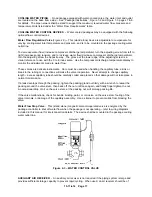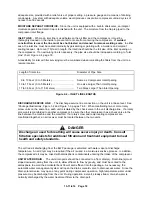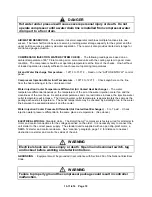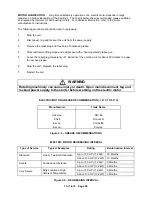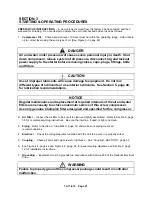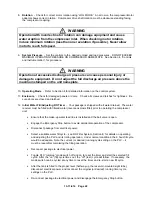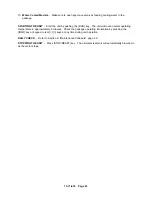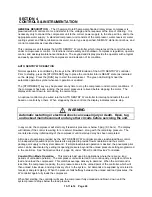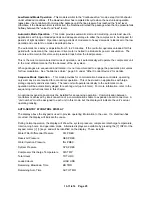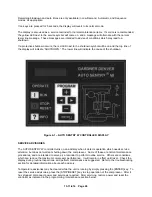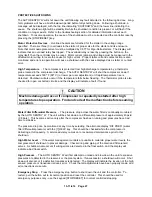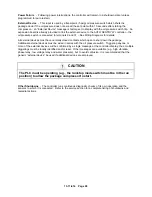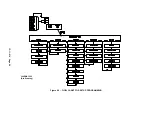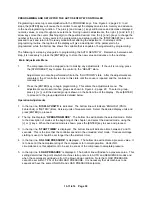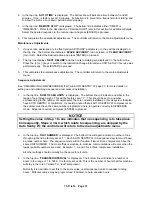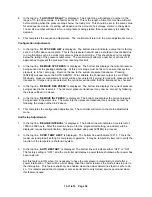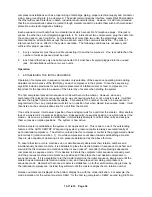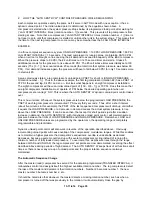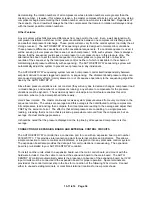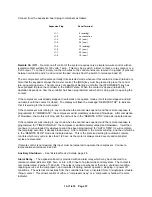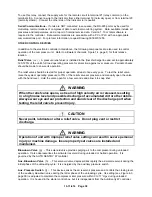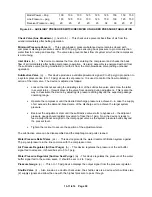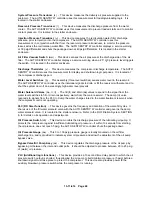
13-11-614 Page 25
Low Demand Mode Operation
- This mode is similar to the “Continuous Run” mode, except for its behavior
under unloaded conditions. If the blowdown timer has completed its cycle when the next unload operation
takes place, the controller will not reload the package until the line pressure has reached the “load” level.
Otherwise, if the blowdown timer is still active, the machine will reload the package when the line pressure falls
halfway between the “unload” and “load” levels.
Automatic Mode Operation
- This mode provides automatic start and timed stop, and is best used in
applications with long unloaded periods and adequate storage to allow the compressor to be stopped for
periods of light demands. Operation during periods of moderate to heavy demands is identical to the low
demand and constant run modes described above.
The automatic time delay is adjustable from 5 to 20 minutes. If the controller operates unloaded for this
period with no demand, the compressor drive motor is halted to eliminate its power consumption. The
controls will remain in this state until pressure drops below the load pressure.
This is the most common selected mode of operation, as it automatically will operate the compressor unit
in the most efficient manner for the demand of the air system.
When packages are sequenced and rotated, it is not recommended to engage the pneumatic pilot valves
for flow modulation. See “Subtractive Valve”, page 39, under “Other Control Devices” for details.
Sequence Mode Operation
- This mode provides for communication between controllers, operating
only as many as are required for economical operation. This is best used on applications with large
storage capacity and diverse loads. The lead unit will operate identically to the automatic mode;
operation will be automatically staged for each lag unit (up to 8 total). For more information, refer to the
sequencing instructions later in this chapter.
An optional expansion board must be installed for sequencing operation. Communication between
controllers is achieved by interconnection of a communications cable to expansion board connectors. A
”unit number” must be assigned to each unit in this mode, but the display will indicate the unit’s actual
operating ranking.
AUTO-SENTRY W CONTROL DISPLAY
The display above the keypad is used to provide operating information to the user. If a shutdown has
occurred, the display will indicate the cause.
During normal operation, the display will show the system pressure, compressor discharge temperature,
total running hours, and operation mode. Alternate displays are available by pressing the [?] INFO or the
keypad cursor [<] [>] keys, and will be identified on the display. These include:
Water Filter Differential Pressure
DIF PRES
Reservoir Pressure
RES PRES
Water Injection Pressure
INJ PRES
System Pressure
SYS PRES
Compressor Discharge Temperature
DIS TMP
Total Hours
TOT HRS
Loaded Hours
LOAD HRS
Remaining Blowdown Time
BD TMR
Remaining Auto Time
AUTO TMR
Summary of Contents for ROTORCHAMP EWF99C-100
Page 7: ...13 11 614 Page 7 Figure 1 2 PACKAGE ILLUSTRATION AIR COOLED 309EWF797 A Ref Drawing ...
Page 8: ...13 11 614 Page 8 Figure 1 3 PACKAGE ILLUSTRATION WATER COOLED 310EWF797 A Ref Drawing ...
Page 9: ...13 11 614 Page 9 Figure 1 4 AIR COOLED SCHEMATIC 307EWF797 A Ref Drawing ...
Page 10: ...13 11 614 Page 10 Figure 1 5 WATER COOLED SCHEMATIC 308EWF797 A Ref Drawing ...
Page 29: ...13 11 614 Page 29 Figure 4 2 FLOW CHART FOR SETUP PROGRAMMING 300EWC1255 Ref Drawing ...
Page 43: ...13 11 614 Page 43 303EWF546 A Ref Drawing Page 2 of 2 ...
Page 45: ...13 11 614 Page 45 304EWF546 A Ref Drawing Page 2 of 2 ...
Page 47: ...13 11 614 Page 47 305EWF546 A Ref Drawing Page 2 of 2 ...







